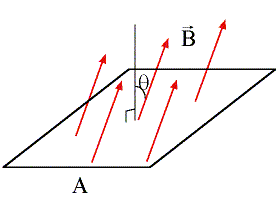Magnetic Flux
The magnetic flux is the amount of magnetic field that passes perpendicularly through an area. It is determined by the magnitude of the magnetic field (B) and the area (A), as well as the angle through which the field goes through the area (θ).

![]()
Faraday’s Law
Faraday’s Law says that a change in magnetic flux induces a current, and therefore, voltage. This means that a change in the magnetic field (B), the area (A), or the angle (θ) will create a current by changing the magnetic flux ( ϕ ).

Application
So how do these physics concepts apply to the electrical system of the bike? The alternator is what generates a current for the whole system. As the rotor spins with the engine, the orientation of its magnets change, causing a change in the magnetic field within the stator. According to Faraday’s Law, this change in magnetic field changes the magnetic flux, which creates a current. This current is induced in the wire coils of the stator and is sent to other parts of the electrical system to be used.
Experiment
We did a small experiment to see Faraday’s Law in action. As we spun two separate rotors on the tester machine, we increased their speed and measured the frequency of spin. We also measured the magnitude of the voltage induced. Then we graphed the frequency versus the voltage to see how the two are related.


As we increased the frequency, or the rate of spin, of the rotor, we were increasing the rate at which the magnetic fields of the magnets was changing. As the change in magnetic flux becomes greater, the induced current also increases. This leads to a higher voltage. This relationship is depicted by the graphical results of the experiment. Notice the linear relationship between the frequency and the voltage. This makes sense since the equations for magnetic flux and Faraday’s Law both have only variables of degree one.